Driving Factors of Shading Adjustment Behavior Based on Social Cognitive Theory and Structural Equation Modeling
Abstract
1. Introduction
2. Literature Review
3. Methodology
3.1. Roadmap
3.2. Structural Equation Modeling
3.3. Social Cognitive Theory
- (1)
- Triadic reciprocal determinism posits that human behavior is shaped not by single internal or external factors, but by the continuous interaction among personal factors, environmental factors, and behavior. It proposes a PBE (Person–Behavior–Environment) interaction model comprising these three factors, as depicted in Figure 2.
- (2)
- Observational learning, also known as vicarious learning, contrasts with direct experiential learning. Essentially, it involves the observer indirectly acquiring cognitive skills or behavioral patterns demonstrated by a model (the observed), and subsequently exhibiting these behaviors in similar scenarios. Unlike Thorndike’s trial-and-error theory and Skinner’s operant conditioning theory, which posit that human knowledge and skills derive primarily from direct learning, Bandura posits that human learning, experience, and skills are largely acquired through indirect observational learning [36,37]. Bandura asserts that observational learning is a pivotal form of human learning and exemplifies human vicarious learning ability. It entails the observer encoding the observed behavioral structures and environmental events demonstrated by the model into symbolic representations within the brain, thereby internally guiding the observer to replicate similar behaviors in the future. Thus, the capability for symbolic representation, one of the five fundamental human capabilities, plays a crucial role in observational learning. Observational learning unfolds through a sequence of four processes, attention, retention, reproduction, and motivation, culminating in the observer’s indirect acquisition of behaviors demonstrated by the model.
- (3)
- Self-efficacy involves an individual’s cognitive assessment of their ability to organize and execute actions required to achieve goals [38]. It pertains not to the skills one possesses, but rather to one’s judgment of what can be accomplished with those abilities. Simply put, self-efficacy is an individual’s perception and evaluation of their ability to influence themselves, or it can be understood as an internal belief in their understanding and confidence in their abilities. Bandura asserts that self-efficacy, as a crucial driver within an individual’s self-system, influences their behavioral choices, the effort they invest in achieving goals, their perseverance in facing challenges, and their emotional state (whether confident or anxious) when undertaking tasks. It significantly determines whether individuals undertake specific actions, often independently of whether they possess the requisite skills to execute those actions. There are four primary sources of self-efficacy: successful personal experiences, observed experiences of others, encouragement and affirmation from others, and psychological and physiological states encountered when facing tasks. Self-efficacy, to a considerable extent, serves as the key to unlocking an individual’s potential. When an individual’s self-efficacy aligns with their actual knowledge and skills, their potential for achievement can be maximized [39].
3.4. Questionnaire Design
4. Results and Discussion
4.1. Determination of Driving Factors
4.2. Questionnaire Analysis
4.2.1. Reliability Test
4.2.2. Validity Test
4.3. Model Construction
4.4. Model Fit
4.5. Model Evaluation
4.6. Analysis of Model Results
4.7. Discussion
5. Conclusions
- (1)
- There is a significant mutual interaction among shading adjustment behavior, personal factors, and environmental factors:
- (2)
- The influence of social environmental factors:
- (3)
- Differential effects of environmental factors:
- (4)
- Differential effects of personal awareness factors:
- (1)
- This research primarily conducted qualitative studies on the driving factors of shading adjustment behavior. Quantifying these factors in specific contexts and applying them across various studies still necessitates extensive follow-up research for deeper exploration.
- (2)
- In terms of the impact of the external natural environment on buildings, this study employed a new classification method. The driving factors were categorized into environmental and personal factors, with environmental factors further subdivided into light environment, thermal environment, and social environment factors. Regional climate differences are indirectly reflected by combining thermal environment, light environment, and personal factors, influencing indoor shading adjustment behavior. This approach obscures the unique climatic characteristics of different regions. Given the significant climate variations across regions, research focusing on the distinct climatic and sociocultural features of various areas is essential.
- (3)
- This study utilized social cognitive theory and structural equation modeling to investigate the driving factors of shading adjustment behavior. The study of building occupant behavior is interdisciplinary, integrating aspects of psychology, environmental science, sociocultural studies, and biology. Exploring the applicability of the research methods used in this study to broader investigations of building occupant behavior will be a focus of our future research.
Author Contributions
Funding
Data Availability Statement
Conflicts of Interest
Appendix A. Questionnaire
- Office Building Shading Adjustment Behavior Questionnaire
- Section I: Basic Information
- Section II: Office Situation
- Section III: Shading Adjustment Frequency
- Section IV: Reasons for Using Shading
- Section V: Reasons for Not Using Shading
- Section VI: Light and Thermal Environment
- Section VII: Social Environment
- Section VIII: Personal Awareness and Preferences
- Section IX: Comfort Preferences
Appendix B. Glossary
| Term | Abbreviation | Definition |
| Structural Equation Modeling | SEM | SEM is a statistical method for analyzing the relationships between observed and latent variables, combining a factor analysis and regression analysis to examine complex theoretical models. |
| Social Cognitive Theory | SCT | Social cognitive theory (SCT) is a framework for understanding, predicting, and changing human behavior. It emphasizes the role of observational learning, social experiences, and reciprocal determinism, where personal factors, behavior, and environmental influences interact. |
| Person–Behavior–Environment Model | PBE Model | The PBE model is a framework that highlights the interaction between an individual’s characteristics, their actions, and their surrounding context. |
| Kaiser–Meyer–Olkin Test | KMO Test | The KMO test measures sampling adequacy for a factor analysis; higher values suggest better suitability. |
| Chi-square Minimum Discrepancy | CMIN | CMIN assesses model fit in SEM by measuring discrepancies between expected and observed data; lower values indicate better fit. |
References
- Srivastav, S.; Jones, P. Use of traditional passive strategies to reduce the energy use and carbon emissions in modern dwellings. Int. J. Low-Carbon Technol. 2009, 4, 141–149. [Google Scholar] [CrossRef]
- Jiang, M.P.; Tovey, K. Overcoming barriers to implementation of carbon reduction strategies in large commercial buildings in China. Build. Environ. 2010, 45, 856–864. [Google Scholar] [CrossRef]
- O’Brien, W.; Gunay, H.B. Mitigating office performance uncertainty of occupant use of window blinds and lighting using robust design. Build. Simul. 2015, 8, 621–636. [Google Scholar] [CrossRef]
- Andersen, R.V.; Olesen, B.; Toftum, J. Simulation of the effects of occupant behaviour on indoor climate and energy consumption. In Proceedings of the Clima 2007 WellBeing Indoors Congress, Helsinki, Finland, 10–14 June 2007; pp. 1–7. [Google Scholar]
- Clevenger, C.M.; Haymaker, J. The impact of the building occupant on energy modeling simulations. In Proceedings of the Joint International Conference on Computing and Decision Making in Civil and Building Engineering, Montreal, QC, Canada, 14–16 June 2006; pp. 1–10. [Google Scholar]
- Haldi, F.; Robinson, D. The impact of occupants’ behaviour on building energy demand. J. Build. Perform. Simul. 2011, 4, 323–338. [Google Scholar] [CrossRef]
- Wang, X.T.; Luan, L.J.; Li, Y.A.; Liu, X.L. Effect of external shading area on energy consumption of office buildings in cold area. Build. Energy Effic. 2023, 51, 54–57. [Google Scholar]
- Yuan, Y.; Zhang, S.; Zhu, N.; Zhao, M.M. Practical analysis and simulation on light environments and energy consumption in campus buildings. China Illum. Eng. J. 2022, 33, 120–128. [Google Scholar]
- Zhang, M.Y.; Xing, T.; Sun, Y. Application of EnergyPlus in building energy saving and consumption reduction. Constr. Econ. 2022, 3, 574–578. [Google Scholar]
- Tzempelikos, A.; Bessoudo, M.; Athienitis, A.; Zmeureanu, R. Indoor thermal environmental conditions near glazed facades with shading devices-Part II: Thermal comfort simulation and impact of glazing and shading properties. Build. Environ. 2010, 45, 2517–2525. [Google Scholar] [CrossRef]
- Ding, Y.; Lian, D.Q.; Li, B.Z.; Yao, R.M. Test and analysis of impact of internal shading of external window on indoor environment. J. Civ. Environ. Eng. 2011, 33, 108–113. [Google Scholar]
- Krarti, M. Optimal energy performance of dynamic sliding and insulated shades for residential buildings. Energy 2023, 263, 164–173. [Google Scholar] [CrossRef]
- Hu, T.Y.; Chen, C.K.; Lin, F.Y.; Lin, T.H. Influence of Roller Blinds Shading Strategy on West and South Facing Buildings. Energies 2023, 16, 711. [Google Scholar] [CrossRef]
- Liu, X.; Du, H.W. Research on shading effects of novel electric louver components based on performance simulation in areas with hot summer and warm winter. Chongqing Archit. 2024, 23, 18–21. [Google Scholar]
- Ozarisoy, B. Energy effectiveness of passive cooling design strategies to reduce the impact of long-term heatwaves on occupants’ thermal comfort in Europe: Climate change and mitigation. J. Clean. Prod. 2022, 330, 129675. [Google Scholar] [CrossRef]
- Gunay, H.B.; O’Brien, W.; Beausoleil-Morrison, I.; Gilani, S. Development and implementation of an adaptive lighting and blinds control algorithm. Build. Environ. 2017, 113, 185–199. [Google Scholar] [CrossRef]
- Inkarojrit, V. Balancing Comfort: Occupants’ Control of Window Blinds in Private Offices; University of California: Berkeley, CA, USA, 2015. [Google Scholar]
- Mahdavi, A. Patterns and implications of user control actions in buildings. Indoor Built Environ. 2009, 18, 440–446. [Google Scholar] [CrossRef]
- Hirning, M.; Isoardi, G.; Garcia-Hansen, V. Prediction of discomfort glare from windows under tropical skies. Build. Environ. 2017, 113, 107–120. [Google Scholar] [CrossRef]
- Moscoso, C.; Matusiak, B. Aesthetic perception of a small office with different daylighting systems. Indoor Built Environ. 2018, 27, 1187–1202. [Google Scholar] [CrossRef]
- Rubin, A.I.; Collins, B.L.; Tibbott, R.L. Window Blinds as a Potential Energy Saver: A Case Study. Building Science Series (Final). [Effects of Building Orientation]; Center for Building Technology: Washington, DC, USA, 1978. [Google Scholar]
- Zhang, Y.; Barrett, P. Factors influencing occupants’ blind-control behaviour in a naturally ventilated office building. Build. Environ. 2012, 54, 137–147. [Google Scholar] [CrossRef]
- Boyce, P.R. Observations of the manual switching of lighting. Light. Res. Technol. 1980, 12, 195–205. [Google Scholar] [CrossRef]
- Reinhart, C.F.; Voss, K. Monitoring manual control of electric lighting and blinds. Light. Res. Technol. 2003, 35, 243–258. [Google Scholar] [CrossRef]
- Inoue, T.; Kawase, T.; Ibamoto, T.; Takakusa, S.; Matsuo, Y. The development of an optimal control system for window shading devices based on investigations in office buildings. Ashrae Trans. 1988, 94, 1034–1049. [Google Scholar]
- Haldi, F. Towards a Unified Model of Occupants’ Behaviour and Comfort for Building Energy Simulation; EPFL: Lausanne, Switerland, 2010. [Google Scholar]
- Abdelwahab, S.; Kent, M.G.; Mayhoub, M. Users’ window preferences and motivations of shading control: Influence of cultural characteristics. Build. Environ. 2023, 240, 110455. [Google Scholar] [CrossRef]
- Heydarian, A. A Systematic Approach to Understand and Model the Impact of Lighting Behavior on Building Energy Consumption through Immersive Virtual Environments; University of Southern California: Los Angeles, CA, USA, 2017. [Google Scholar]
- Karlin, B.; Ford, R.; Squiers, C. Energy feedback technology: A review and taxonomy of products and platforms. Energy Effic. 2014, 7, 377–399. [Google Scholar] [CrossRef]
- Li, C.; Li, Z.R.; Zhu, L. Study on sunshade control behavior model in office buildings. Heat. Vent. Air Cond. 2017, 47, 45–48. [Google Scholar]
- Li, C.; Li, Z.R.; Xiao, L. Study on shading control behavior in office buildings. Build. Sci. 2015, 31, 218–221+234. [Google Scholar]
- Wu, M.L. Structural Equation Modeling: Operation and Application of AMOS; Chongqing University Press: Chongqing, China, 2010; Chapter 9; pp. 10–40. [Google Scholar]
- Jacobucci, R.; Grimm, K.J.; Mc Ardle, J.J. Regularized structural equation modeling. Struct. Equ. Model. A Multidiscip. J. 2016, 23, 555–566. [Google Scholar] [CrossRef] [PubMed]
- Shi, D.; Maydeu-Olivares, A. The effect of estimation methods on SEM fit indices. Educ. Psychol. Meas. 2020, 80, 421–445. [Google Scholar] [CrossRef] [PubMed]
- Wang, Y.; Wen, Z.L.; Li, W.; Fang, J. Methodological research and model development on structural equation models in China’s mainland from 2001 to 2020. Adv. Psychol. Sci. 2022, 30, 1715–1733. [Google Scholar] [CrossRef]
- Thorndike, L.E.; Shen, X. The Psychology of labor. Educ. Vocat. 1928, 2, 93–99. [Google Scholar]
- Skinner, B.F. Two types of conditioned reflex and a pseudo type. J. Gen. Psychol. 1935, 12, 66–77. [Google Scholar] [CrossRef]
- Zhang, L.; Lin, Y.C. Moderation and mediation in experimental study. J. Manag. Sci. 2011, 24, 108–116. [Google Scholar]
- Bandura, A. Self Efficacy: The Exercise of Control; East China Normal University Press: Shanghai, China, 2003. [Google Scholar]
- Wang, D.H. An Overview of Bandura’s Self-Efficacy Theory. J. Hubei Norm. Univ. Philos. Soc. Sci. 1992, 5, 98–101. [Google Scholar]
- Higgs, N. Practical and innovative uses of correspondence analysis. J. R. Stat. Soc. Ser. D Stat. 1991, 40, 183–194. [Google Scholar] [CrossRef]

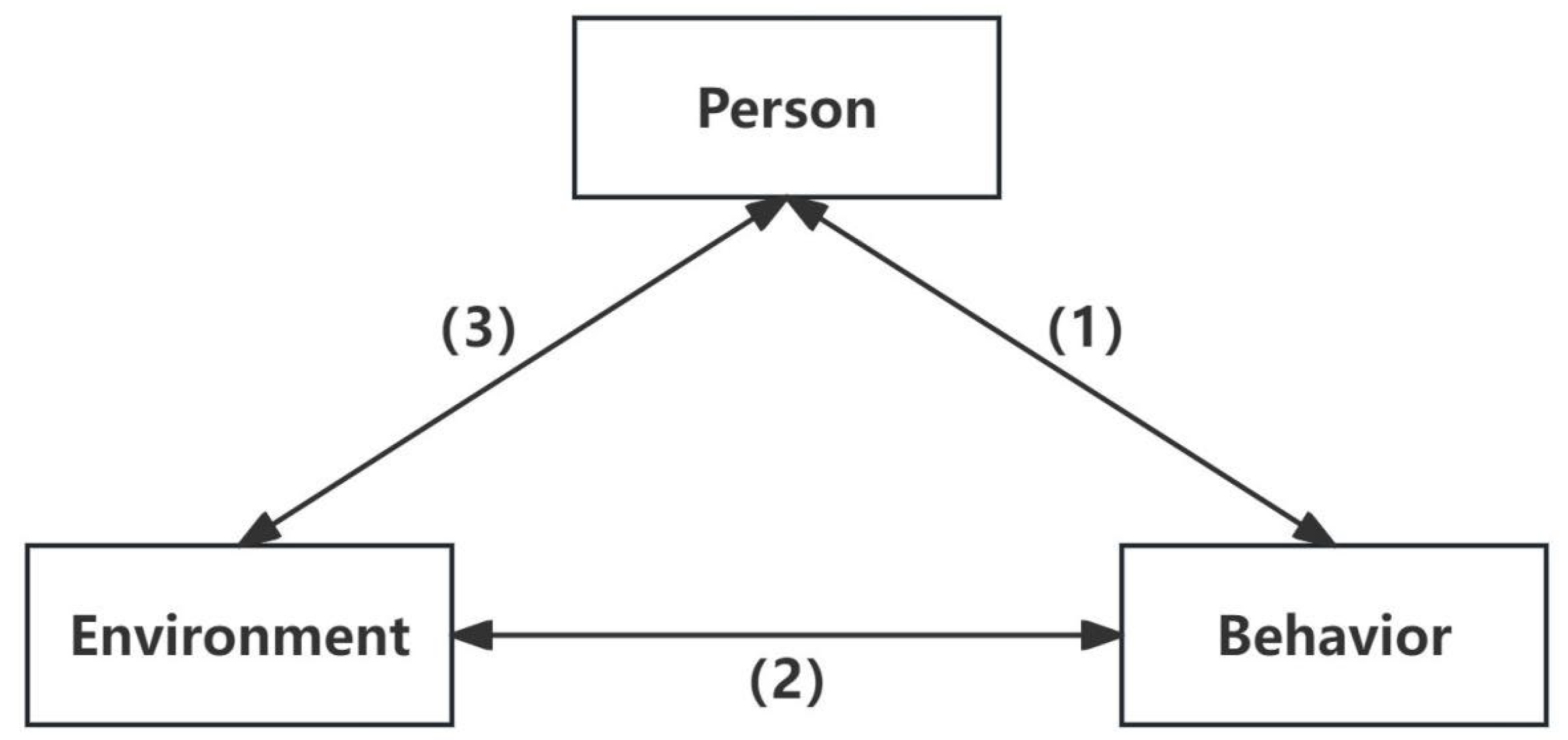
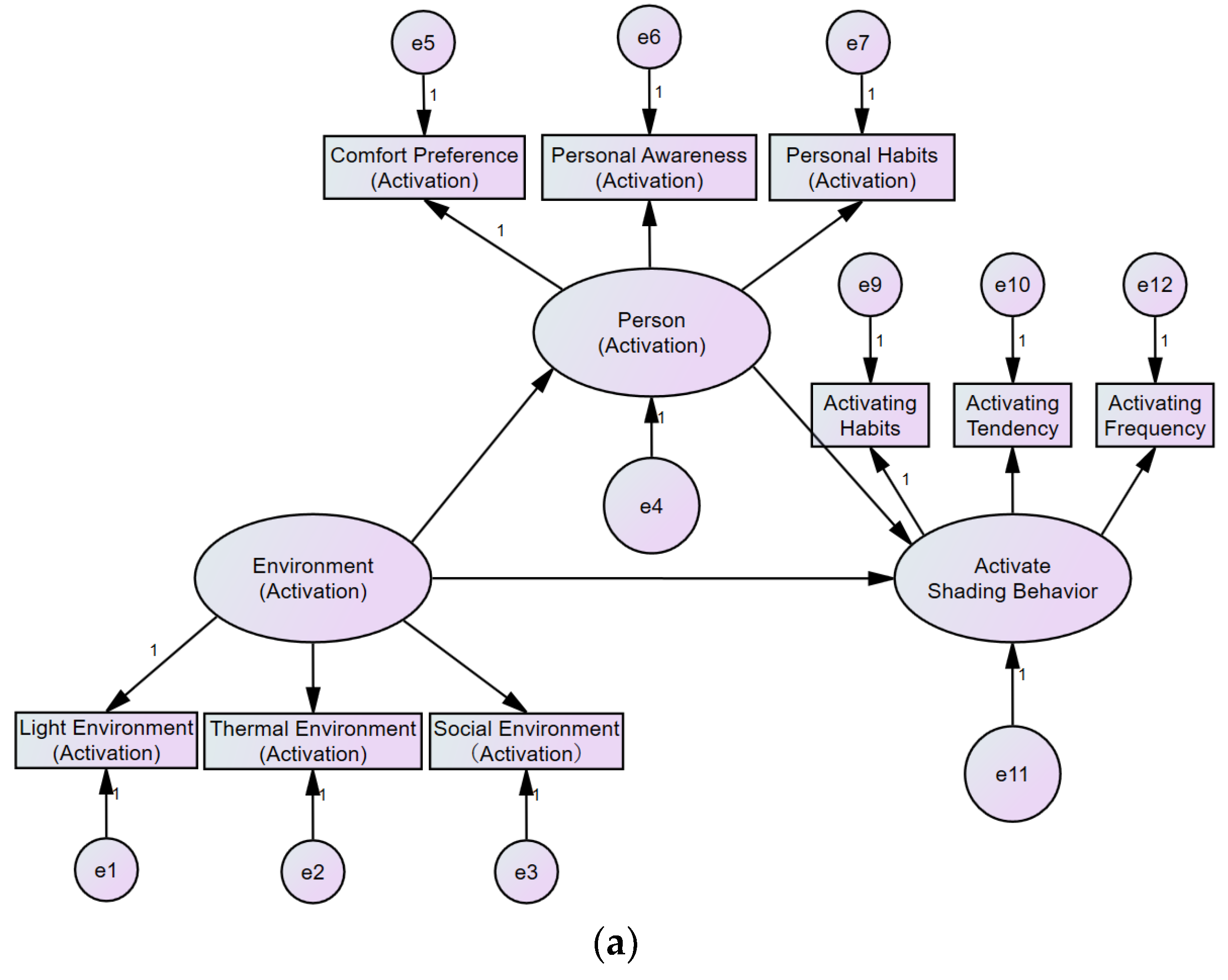
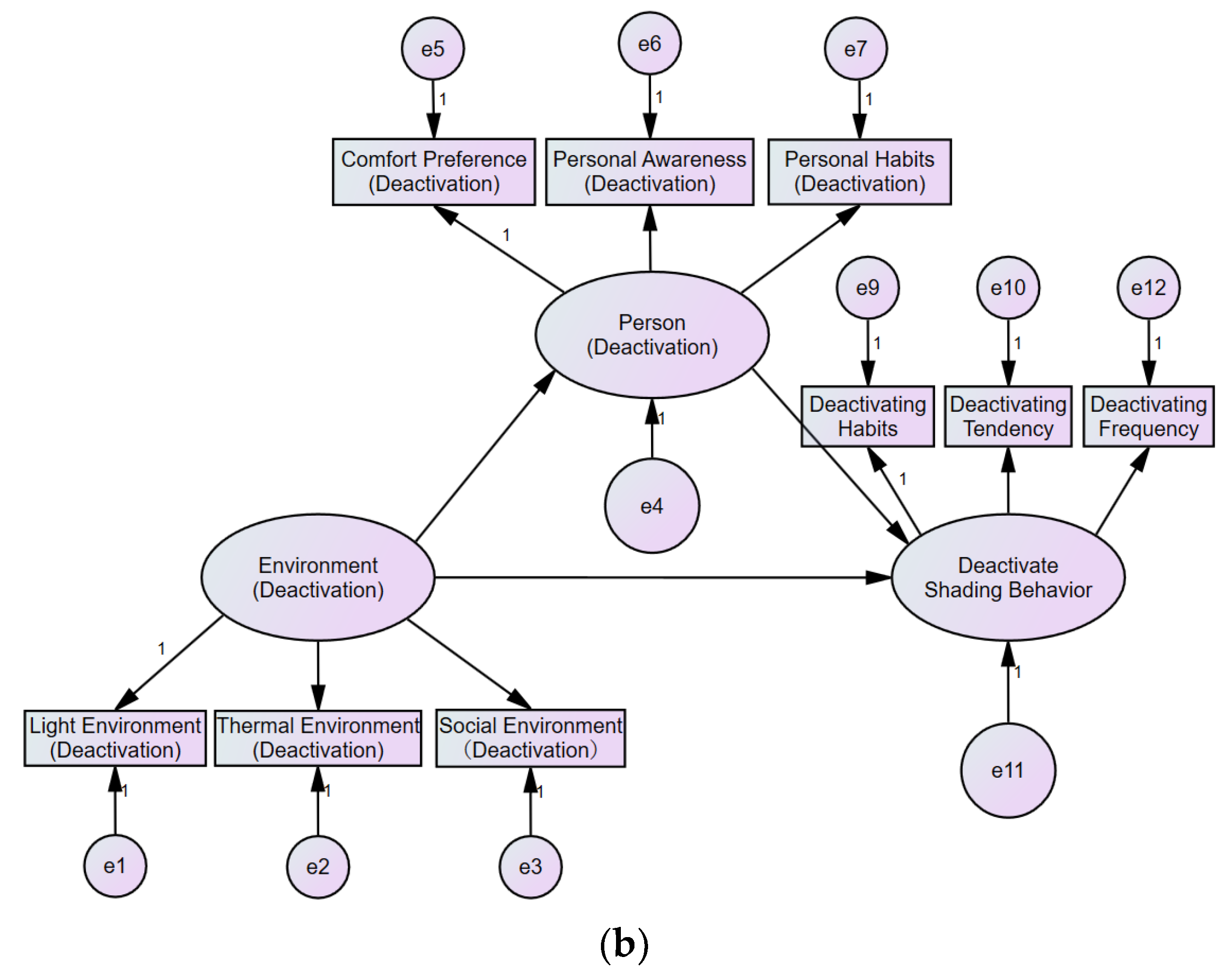
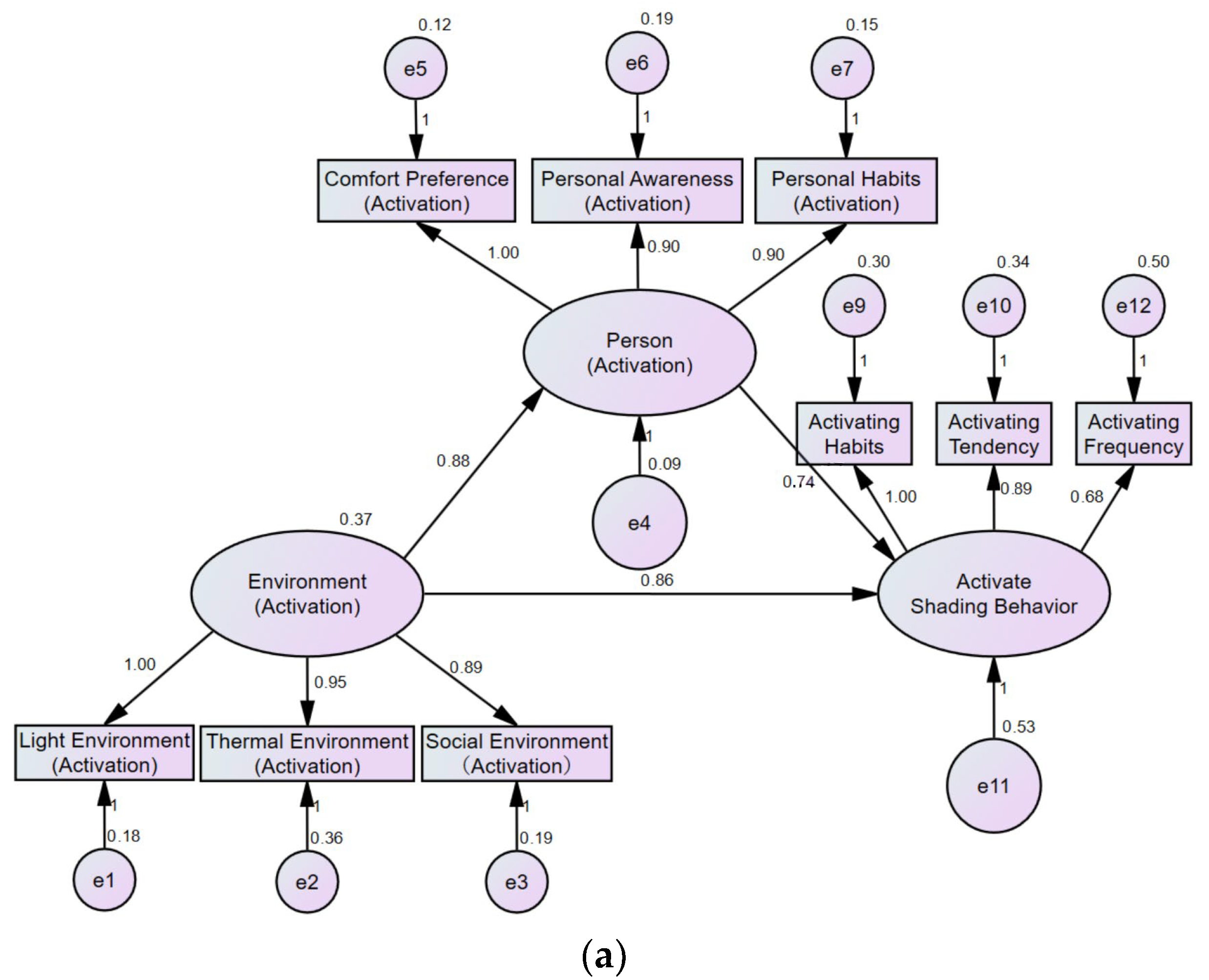
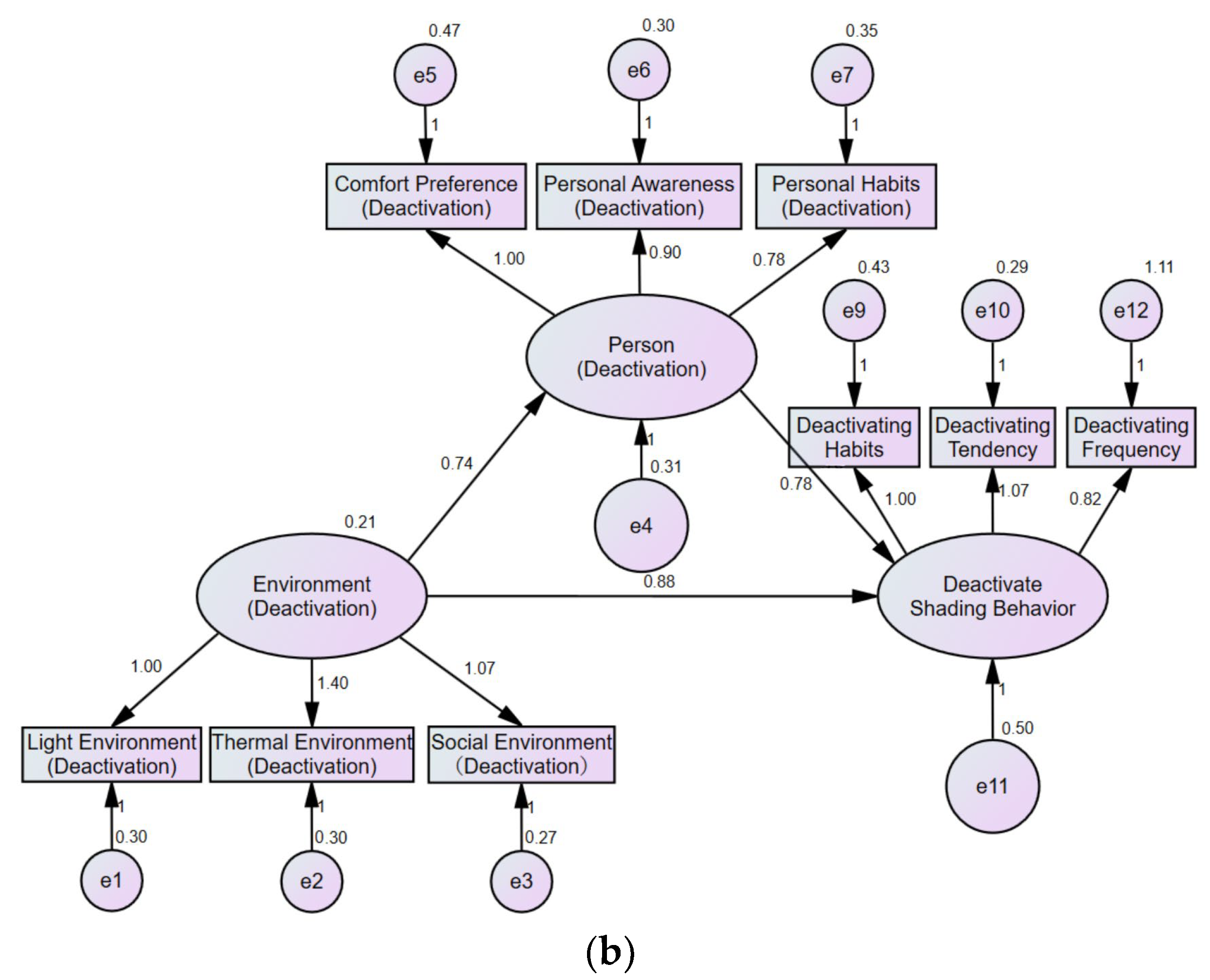
| Shading Function | Influencing Factors | Major Influencing Factors |
|---|---|---|
| Thermal Comfort | Solar radiation heat, thermal adaptability of individuals | Solar radiation (vertical radiation, transmitted radiation), weather conditions, outdoor temperature |
| Light Comfort | Solar radiation, individuals’ light preferences, shading type, lighting use | Solar radiation (outdoor illuminance, brightness), glare, weather conditions (sunny, cloudy), shading type |
| View and Privacy Needs | Building factors, surrounding environmental factors, psychological factors of individuals | Orientation, spatial layout, age, gender, culture |
| Item | Question |
|---|---|
| Person (Activation) | |
| PA1 | In specific seasons, do you feel that the indoor temperature is too hot? |
| I frequently adjust shading facilities to ensure that the indoor environment is visually and physically comfortable for me. | |
| PA2 | Frequency of activated shading for protecting privacy. |
| I believe rational shading can significantly reduce energy consumption. | |
| For me, shading is not only about adjusting light but also a means to protect privacy. | |
| PA3 | Even if there are no significant changes in external conditions, I habitually adjust shading facilities. |
| I think adjusting indoor temperature through shading is more natural and comfortable than using air conditioning. | |
| Environment (Activation) | |
| EA1 | Frequency of activated shading for reducing glare. |
| Frequency of activated shading for avoiding sunlight affecting work. | |
| EA2 | Frequency of activated shading for controlling indoor temperature. |
| Frequency of activated shading for addressing indoor overheating issues. | |
| EA3 | My family and friends often adjust shading habits. |
| I am willing to accept advice from professionals on the best shading practices. | |
| Activate Shading Behavior | |
| ASB1 | I adjust shading facilities daily to adapt to different environmental conditions. |
| ASB2 | I often adjust shading facilities to reflect my satisfaction with current lighting and temperature. |
| ASB3 | Frequency of using shading in the office. |
| Person (Deactivation) | |
| PD1 | I am highly satisfied with the natural lighting in my office. |
| I am willing to sacrifice some comfort for maintenance. | |
| PD2 | Energy conservation is an important factor I consider when using shading facilities. |
| PD3 | I prefer natural lighting, even if it means the indoor space may be warmer at times. |
| Environment (Deactivation) | |
| ED1 | Frequency of deactivated shading for increasing room brightness. |
| Frequency of deactivated shading for enjoying sunlight exposure. | |
| ED2 | Frequency of deactivated shading for increasing indoor temperature. |
| ED3 | My shading behavior is influenced by the attitudes and behaviors of people around me. |
| Others’ shading adjustments affect me. | |
| I am concerned that my shading adjustments may affect others. | |
| Deactivate Shading Behavior | |
| DSB1 | I adjust shading facilities daily to adapt to different environmental conditions. |
| DSB2 | I often adjust shading facilities to reflect my satisfaction with current lighting and temperature. |
| DSB3 | Frequency of not using shading in the office. |
| Latent Variable | Observed Variables |
|---|---|
| Environmental Factors | Light Environment |
| Thermal Environment | |
| Social Environment | |
| Personal Factors | Comfort Preference |
| Personal Awareness | |
| Personal Habits | |
| Shading Adjustment Behavior | Adjustment Habits |
| Adjustment Tendency | |
| Adjustment Frequency |
| Cronbach’s α Coefficient | Cronbach’s α Coefficient Based on Standardized Items |
|---|---|
| 0.916 | 0.918 |
| First-Level Indicators | Secondary-Level Indicators | Cronbach’s α Coefficient after Removing Items | Cronbach’s α Coefficient |
|---|---|---|---|
| Environment | Light environment | 0.901 | 0.905 |
| Thermal environment | 0.904 | ||
| Social environment | 0.899 | ||
| Person | Personal habits | 0.907 | 0.908 |
| Personal awareness | 0.875 | ||
| Comfort preference | 0.901 | ||
| Behavior | Activating habits | 0.907 | 0.911 |
| Activating tendency | 0.902 | ||
| Activating frequency | 0.904 |
| Method | Result | |
|---|---|---|
| KMO Sampling Adequacy Measure | 0.836 | |
| Bartlett’s Sphericity Test | Approximate chi-square | 28.908 |
| Degrees of freedom | 25 | |
| Significance | 0.000 | |
| Indicators | Factor 1 | Factor 2 |
|---|---|---|
| Light Environment | 0.147 | 0.702 |
| Thermal Environment | 0.030 | 0.686 |
| Social Environment | 0.186 | 0.567 |
| Comfort Preference | 0.616 | 0.003 |
| Personal Awareness | 0.754 | 0.018 |
| Personal Habits | 0.664 | 0.045 |
| Category | Relative Chi-Square | Residual Mean Square | Comparative Fit Index | Tucker–Lewis Index | Approximate Error Mean Square Root | Non-Normed Fit Index | Normed Fit Index | Incremental Fit Index |
|---|---|---|---|---|---|---|---|---|
| Hypothesized Model | 0.195 | 0.041 | 0.992 | 0.917 | 0.053 | 0.990 | 0.954 | 0.992 |
| Fit Standards | <3 | <0.05 | >0.90 | >0.85 | <0.80 | >0.90 | >0.90 | >0.90 |
| Fit Assessment | Fit | Fit | Fit | Fit | Fit | Fit | Fit | Fit |
| Variable | Path | Variable | Estimate | Standard Error | Critical Value | p-Value | Standardized Estimate |
|---|---|---|---|---|---|---|---|
| Activate shading behavior | <--- | Environment (activation) | 0.860 | 0.089 | 9.602 | *** | 0.97 |
| Activate shading behavior | <--- | Person (activation) | 0.740 | 0.091 | 9.856 | *** | 0.91 |
| Person (activation) | <--- | Environment (activation) | 0.883 | 0.072 | 12.308 | *** | 0.85 |
| Activating habits | <--- | Activate shading behavior | 1.000 | *** | 0.83 | ||
| Activating tendency | <--- | Activate shading behavior | 0.894 | 0.046 | 19.298 | *** | 0.89 |
| Activating frequency | <--- | Activate shading behavior | 0.675 | 0.046 | 14.586 | *** | 0.82 |
| Comfort preference (activation) | <--- | Person (activation) | 1.000 | *** | 0.85 | ||
| Personal awareness (activation) | <--- | Person (activation) | 0.902 | 0.063 | 14.431 | *** | 0.88 |
| Personal habits (activation) | <--- | Person (activation) | 0.903 | 0.058 | 15.494 | *** | 0.84 |
| Light environment (activation) | <--- | Environment (activation) | 1.000 | *** | 0.88 | ||
| Thermal environment (activation) | <--- | Environment (activation) | 0.953 | 0.085 | 11.270 | *** | 0.80 |
| Social environment (activation) | <--- | Environment (activation) | 0.890 | 0.069 | 12.947 | *** | 0.82 |
| Variable | Path | Variable | Estimate | Standard Error | Critical Value | p-Value | Standardized Estimate |
|---|---|---|---|---|---|---|---|
| Deactivate shading behavior | <--- | Environment (deactivation) | 0.880 | 0.090 | 12.843 | *** | 0.89 |
| Deactivate shading behavior | <--- | Person (deactivation) | 0.780 | 0.079 | 11.449 | *** | 0.84 |
| Person (deactivation) | <--- | Environment (deactivation) | 0.737 | 0.144 | 5.106 | *** | 0.79 |
| Deactivating habits | <--- | Deactivate shading behavior | 1.000 | *** | 0.81 | ||
| Deactivating tendency | <--- | Deactivate shading behavior | 1.073 | 0.057 | 18.960 | *** | 0.74 |
| Deactivating frequency | <--- | Deactivate shading behavior | 0.820 | 0.056 | 16.586 | *** | 0.86 |
| Comfort preference (deactivation) | <--- | Person (deactivation) | 1.000 | *** | 0.88 | ||
| Personal awareness (deactivation) | <--- | Person (deactivation) | 0.902 | 0.063 | 14.431 | *** | 0.79 |
| Personal habits (deactivation) | <--- | Person (deactivation) | 0.780 | 0.128 | 13.466 | *** | 0.84 |
| Light environment (deactivation) | <--- | Environment (deactivation) | 1.000 | *** | 0.89 | ||
| Thermal environment (deactivation) | <--- | Environment (deactivation) | 1.396 | 0.162 | 8.632 | *** | 0.93 |
| Social environment (deactivation) | <--- | Environment (deactivation) | 1.069 | 0.129 | 8.284 | *** | 0.76 |
| Number | Model Hypothesis | Result |
|---|---|---|
| Hypothesis 1 | Environmental factors (activation) have a positive correlation with activating shading behavior | Supported |
| Hypothesis 2 | Personal factors (activation) have a positive correlation with activating shading behavior | Supported |
| Hypothesis 3 | Environmental factors (activation) have a positive correlation with personal factors (activation) | Supported |
| Hypothesis 4 | Environmental factors (deactivation) have a positive correlation with deactivating shading behavior | Supported |
| Hypothesis 5 | Personal factors (deactivation) have a positive correlation with deactivating shading behavior | Supported |
| Hypothesis 6 | Environmental factors (deactivation) have a positive correlation with personal factors (deactivation) | Supported |
Disclaimer/Publisher’s Note: The statements, opinions and data contained in all publications are solely those of the individual author(s) and contributor(s) and not of MDPI and/or the editor(s). MDPI and/or the editor(s) disclaim responsibility for any injury to people or property resulting from any ideas, methods, instructions or products referred to in the content. |
© 2024 by the authors. Licensee MDPI, Basel, Switzerland. This article is an open access article distributed under the terms and conditions of the Creative Commons Attribution (CC BY) license (https://creativecommons.org/licenses/by/4.0/).
Share and Cite
Yuan, J.; Yao, J.; Zheng, R. Driving Factors of Shading Adjustment Behavior Based on Social Cognitive Theory and Structural Equation Modeling. Sustainability 2024, 16, 7103. https://doi.org/10.3390/su16167103
Yuan J, Yao J, Zheng R. Driving Factors of Shading Adjustment Behavior Based on Social Cognitive Theory and Structural Equation Modeling. Sustainability. 2024; 16(16):7103. https://doi.org/10.3390/su16167103
Chicago/Turabian StyleYuan, Jinyu, Jian Yao, and Rongyue Zheng. 2024. "Driving Factors of Shading Adjustment Behavior Based on Social Cognitive Theory and Structural Equation Modeling" Sustainability 16, no. 16: 7103. https://doi.org/10.3390/su16167103
APA StyleYuan, J., Yao, J., & Zheng, R. (2024). Driving Factors of Shading Adjustment Behavior Based on Social Cognitive Theory and Structural Equation Modeling. Sustainability, 16(16), 7103. https://doi.org/10.3390/su16167103







